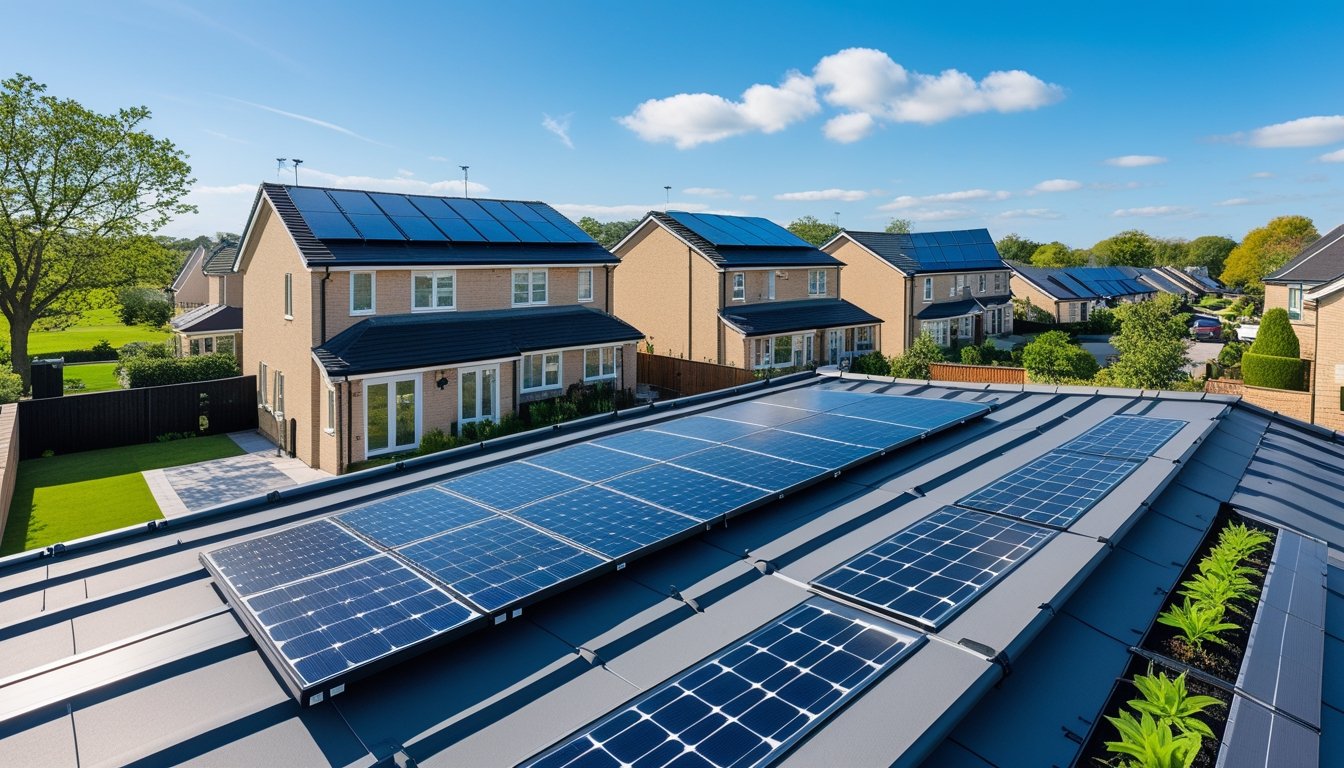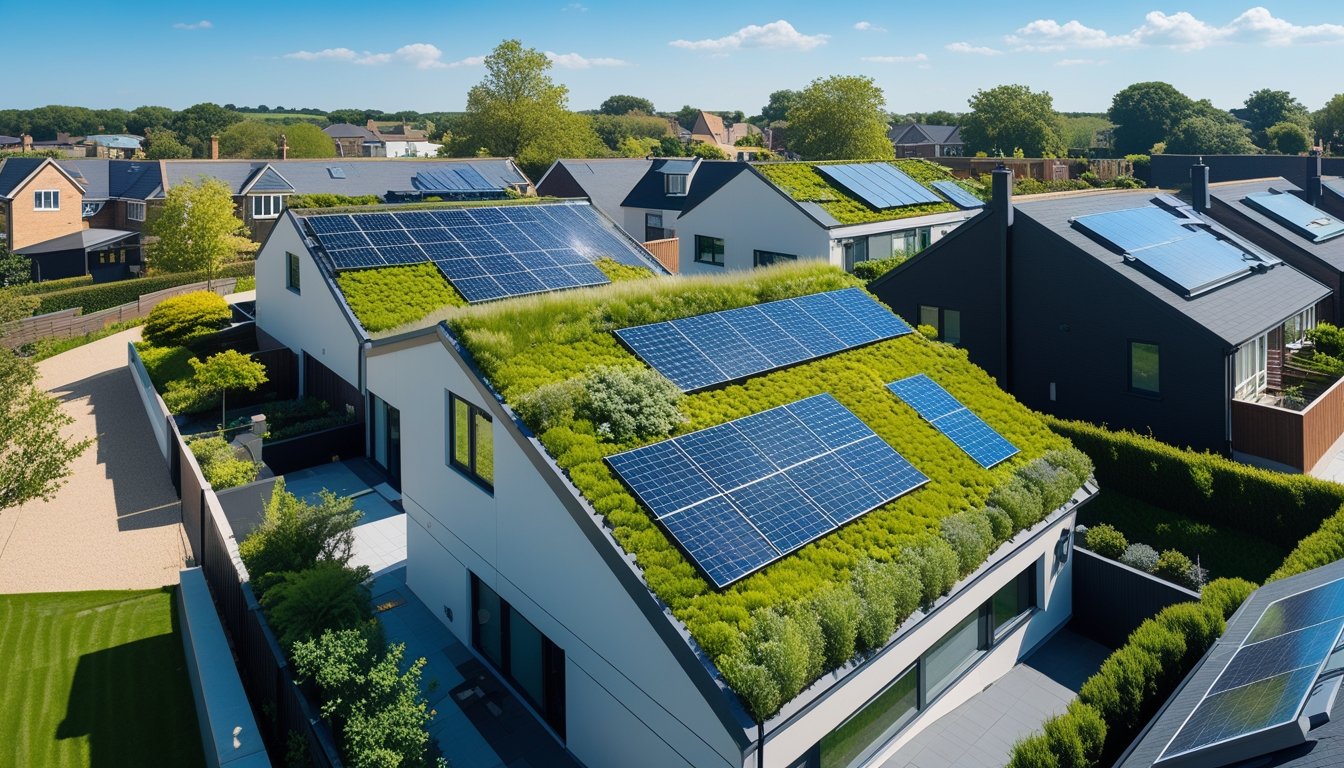Late updated: 28 Nov 2025 13:11
Written by: Eleanor Hartman
Innovative Eco-Friendly Roofing Solutions For UK Homes: Advancing Sustainability In Residential Design
Sustainable roofing has become an increasingly crucial consideration for UK homeowners eager to lower energy costs and contribute to a greener planet. With technological advancements, we now have access to innovative and eco-friendly roofing solutions that can profoundly impact both the environment and our homes' energy efficiency. Eco-friendly roofing options can not only reduce our carbon footprint but also enhance the long-term value and comfort of our homes.

Sustainable materials and cutting-edge designs are transforming the roofing industry, offering solutions that go beyond traditional methods. Contemporary eco-friendly roofing includes options like solar panels, green roofs, and cool roofs, which provide multiple benefits ranging from insulating properties to renewable energy generation. These innovations are supported by UK government incentives, making them more accessible to homeowners keen on making environmentally responsible choices.
The impact of these roofing innovations extends far beyond aesthetics. They actively contribute to energy efficiency, reducing reliance on non-renewable energy sources and contributing to a more sustainable future. As more UK homeowners embrace these solutions, we take meaningful steps toward mitigating the effects of climate change.
Key Takeaways
- Eco-friendly roofing enhances home value and comfort
- Innovative designs support energy efficiency
- Government incentives increase accessibility
Key Innovative Eco-Friendly Roofing Solutions
In the realm of eco-friendly roofing solutions for UK homes, various innovations stand out, each with unique benefits. Options such as green roofs, solar roofs, and recycled materials offer environmentally friendly alternatives that enhance sustainability and efficiency.
Green Roofs and Living Roof Systems
Green roofs, also known as living roof systems, incorporate layers of vegetation and soil on rooftops. This design helps reduce urban heat and enhances biodiversity by providing habitats for native plants, wildflowers, and grasses. In the UK, where rainfall is frequent, green roofs can also assist in managing stormwater, reducing runoff, and lowering flood risks. Beyond environmental benefits, they offer insulation advantages, reducing energy costs. By utilising local flora, green roofs can thrive with minimal maintenance while supporting eco-friendly goals. These systems transform otherwise unused spaces into vibrant areas that contribute positively to urban landscapes.
Solar Roofs and Solar Panels Integration
Solar roofs integrate solar panels directly into the roofing materials, turning sunlight into electricity. This innovation in sustainable roofing solutions stands out for its efficiency in harnessing solar energy. By opting for solar roofs, homeowners can significantly reduce reliance on nonrenewable energy sources, lowering utility bills and carbon footprints. Advances in technology have made these systems more efficient and aesthetically pleasing than ever. Installation can be customised to maximise solar exposure, making them adaptable to various roof types and orientations. For the UK homeowner, this solution not only contributes to greener living but also enhances home value through energy generation capacity.
Cool Roofs and Reflective Technologies
Cool roofs employ reflective materials to reflect more sunlight and absorb less heat than conventional roofing materials. This results in lower roof temperatures and decreased need for air conditioning, particularly useful in urban areas where heat retention can be an issue. The implementation of these eco-friendly roofs can lead to reduced energy bills and increased indoor comfort. With various colours and finishes available, cool roofs offer flexibility without compromising aesthetics. By lowering energy demands, these roofs contribute to reduced carbon emissions, aligning with broader environmental sustainability goals. Their implementation in the UK can be both a practical and visually appealing addition to homes.
Recycled and Bio-Based Roofing Materials
Utilising recycled and bio-based materials in roofing solutions offers an innovative approach to sustainability. Materials such as reclaimed tiles, recycled rubber, and bio-based shingles reduce landfill waste and resource extraction. These sustainable roofing solutions offer durability and performance comparable to new materials, often with lower environmental impact. The aesthetic appeal can also be substantial, with various styles and finishes available. For environmentally conscious homeowners, selecting recycled materials supports circular economy principles and reduces ecological footprints. These eco-friendly roofing options combine practicality with the commitment to sustainability, demonstrating that recycling can play a significant role in innovative roofing strategies.
Metal Roofs and Environmentally Friendly Alternatives
Metal roofs provide a long-lasting, durable choice that is increasingly recognised for its environmental benefits. Metallurgical advancements have led to new alloys that increase efficiency and lifespan, making metal roofs an appealing environmentally friendly option. Their reflectivity and ability to be recycled at the end of their life cycle enhance their sustainability factor. Available in various finishes and styles, metal roofs can complement a wide range of architectural designs. Equipping homes with such sustainable roofing solutions helps in reducing heat absorption and supports energy efficiency. By choosing metal roofing, homeowners invest in longevity and eco-friendly solutions, aligning with modern sustainability objectives.
Enhancing Energy Efficiency and Sustainability in Roofing

In our pursuit of sustainable construction, energy efficiency and environmental responsibility play pivotal roles. By integrating advanced insulation materials, managing stormwater, and reducing carbon emissions, we enable UK homes to become more energy-efficient and environmentally friendly.
Advanced Roof Insulation Materials
The innovation in roof insulation has led to the development of materials such as vacuum-insulated panels and aerogels. These materials are characterised by their superior thermal performance. By minimising heat loss, they contribute significantly to energy savings, which in turn reduces energy bills for homeowners. Vacuum-insulated panels, for instance, use a core sealed within a vacuum, drastically reducing conductivity. Meanwhile, aerogels, known for their lightweight nature, provide high insulation while being less dense. Both options enhance energy efficiency, offering a sustainable choice for modern roofing.
Stormwater Management and Urban Biodiversity
Stormwater management is vital in urban settings to mitigate flooding and support biodiversity. Sustainable roofing solutions, including green roofs, play a crucial role in this. These roofs absorb rainwater, reducing runoff and lowering the risk of urban flooding. Additionally, they create habitats for various plant and animal species, fostering urban biodiversity. The increased vegetation can help regulate indoor temperatures, thus enhancing the overall energy efficiency of the building. Moreover, by integrating stormwater management into our roofing strategies, we promote a harmonious balance between built environments and nature.
Reducing Carbon Footprint and Energy Bills
Reducing the carbon footprint is a fundamental aspect of our sustainable roofing approach. Incorporating reflective coatings enhances solar reflectance, which helps in maintaining lower indoor temperatures during warmer months. This decreases the reliance on air conditioning, leading to reduced energy consumption and lower energy bills. Sustainable roofing materials such as recycled components also contribute by requiring less energy-intensive processing and reducing waste. By prioritising these elements, we not only decrease emissions but promote a culture of environmental responsibility and sustainable living. This approach reflects our commitment to addressing climate change while meeting the practical needs of homeowners.
Frequently Asked Questions

In our exploration of eco-friendly roofing solutions for UK homes, we've addressed important considerations regarding materials, energy efficiency, costs, durability, retrofitting, and regulations. Understanding these aspects helps in making informed decisions about sustainable roofing.
What are the leading sustainable roofing materials used in UK homes today?
Several materials have emerged as leaders in sustainability. Recycled shingles, metal roofs with high recycled content, and natural slate are popular due to their environmental benefits and aesthetic appeal. These materials are increasingly favoured for their ability to reduce waste and their longevity.
How does green roofing contribute to energy efficiency in residential properties?
Green roofs offer natural insulation, significantly reducing the need for artificial cooling and heating. They help maintain a stable indoor temperature, resulting in lower energy bills. The vegetative layer also plays a role in absorbing rainwater and providing a habitat for wildlife.
What are the initial costs versus long-term savings of installing an eco-friendly roof?
While the upfront costs can be higher than traditional roofing, eco-friendly roofs often lead to substantial long-term savings. Their energy efficiency and durability result in lower utility bills and reduced repair costs over time. Additionally, government incentives can help offset initial expenses.
Which eco-friendly roofing options offer the best durability and low maintenance?
Metal roofs and slate are renowned for their durability and minimal maintenance requirements. These materials can withstand harsh weather conditions and typically have long lifespans. Furthermore, their resistance to mould and algae growth reduces the need for frequent upkeep.
Can you retrofit existing roofs with environmentally friendly materials, and what are the challenges?
Retrofitting is possible with materials like solar panels and green roof systems. However, challenges include structural assessments to ensure load-bearing capacity and potential modifications to accommodate new installations. Proper planning and expertise are essential.
What is the impact of UK building regulations on the installation of eco-friendly roofing systems?
Building regulations influence the types of materials and systems that can be installed. They ensure safety and efficiency standards are upheld, which can affect the choice of eco-friendly solutions. Compliance with these regulations is crucial to successful installation and longevity of roofing systems.